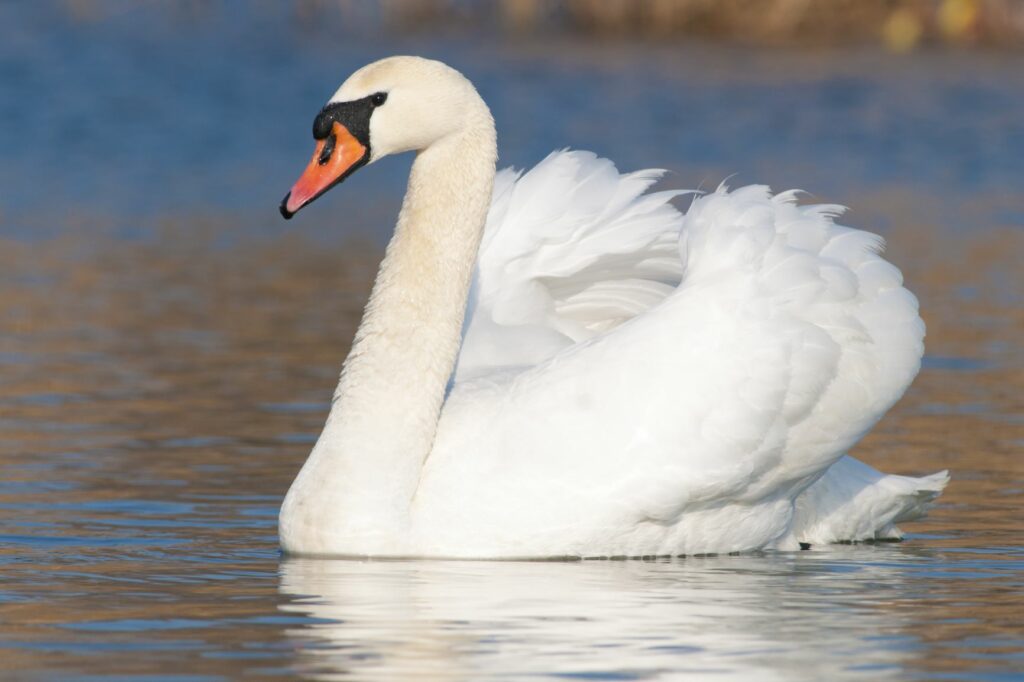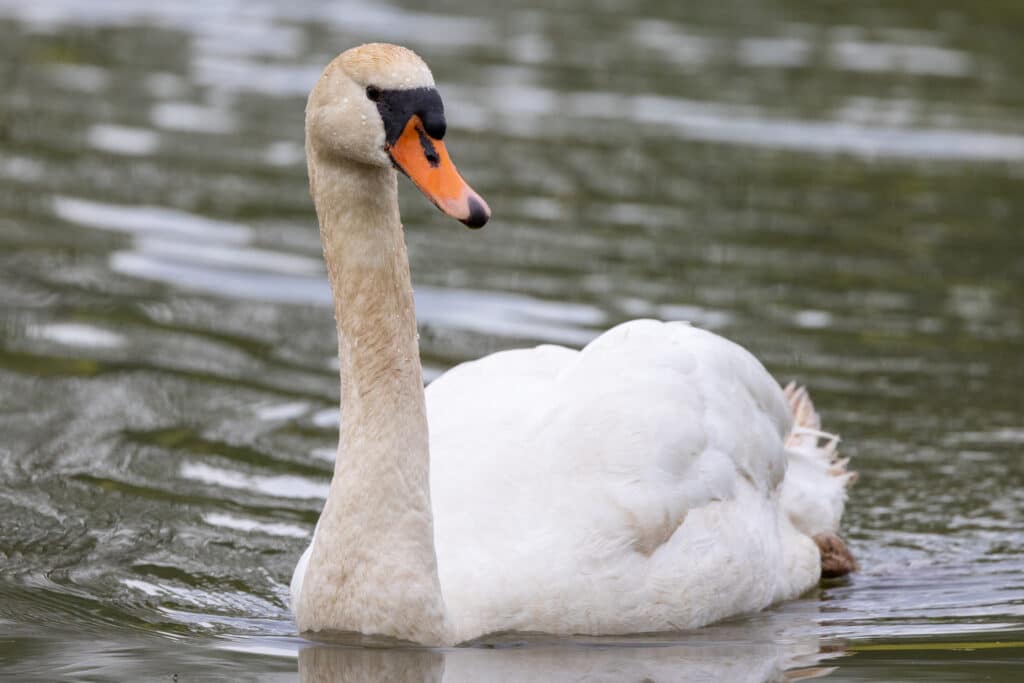The mute swan (Cygnus olor) is a captivating and elegant bird that has fascinated humans for centuries. With its striking appearance, graceful movements, and gentle nature, this species holds a special place in the hearts of bird enthusiasts worldwide. In this article, we will explore the captivating world of mute swans, delving into their physical characteristics, habitat, behaviour, breeding and reproduction, their significance in various cultures, and their ecological impact. Let’s embark on an in-depth journey to discover the enchanting allure of these magnificent creatures.
Appearance
Mute swans are among the largest waterfowl species, measuring between 55 to 63 inches (140 to 160 cm) in length and weighing around 20 to 30 pounds (9 to 14 kg). They are characterised by their majestic white plumage, long and graceful necks, and bright orange bills with a black knob at the base. The male and female mute swans share similar physical features, but the male is usually slightly larger. Their wingspan can reach up to 8 feet (2.4 meters), allowing them to glide effortlessly across the water. Mute swans possess a regal presence, captivating onlookers with their beauty and elegance.

Habitat and Distribution
Originally native to Eurasia, mute swans can now be found in various parts of the world, including North America, Australia, and New Zealand. They inhabit a range of aquatic environments, such as lakes, ponds, rivers, estuaries, and coastal areas. Mute swans prefer freshwater habitats, but they can also adapt to brackish waters. These birds are known for their strong territorial behaviour, establishing their presence in specific areas and defending them vigorously. Their adaptability to various habitats has contributed to their successful colonisation in different regions.
Diet and Feeding Habits
Mute swans are primarily herbivorous birds with a predominantly vegetarian diet. They feed on a variety of aquatic plants, including submerged vegetation and emergent vegetation. Their long necks enable them to reach underwater plants with ease. While foraging, mute swans gracefully dip their heads underwater, sifting through the vegetation to extract their preferred plant matter. Their diet consists of water lilies, pondweeds, sedges, grasses, and other aquatic vegetation. Their feeding habits play a vital role in shaping the ecosystems they inhabit. By consuming plant material, they help control the growth of aquatic vegetation, maintaining a balanced ecosystem.

Breeding and Reproduction
Breeding season for mute swans typically occurs during spring and early summer. These birds form monogamous pairs that bond for life, exhibiting a strong sense of loyalty to their mates. During courtship displays, mute swans engage in elegant rituals, including synchronised head bobbing and neck movements. The female constructs a large nest made of aquatic vegetation near the water’s edge. She lays a clutch of 4 to 8 eggs, which both parents incubate for about 35 to 41 days. The cygnets, as the chicks are called, are born with greyish-brown feathers and take approximately 3 to 4 months to develop their iconic white plumage. The dedication and care exhibited by the parents ensure the survival of their offspring.
Behaviour and Social Structure
Mute swans are known for their calm and graceful demeanour. They often move in a serene and unhurried manner, gliding across the water with apparent effortlessness. These birds are highly territorial and will vigorously defend their nesting areas from intruders. Mute swans communicate through a variety of vocalisations, including a soft trumpeting sound. They are social animals, often forming small family groups or larger flocks during non-breeding seasons. While mute swans are generally peaceful, they can display aggression when their territories or young are threatened. Their behaviour and social structure contribute to their success as a species.

Migration Patterns
Mute swans are generally non-migratory birds, with populations in temperate regions often remaining in their breeding areas year-round. However, some individuals may undertake short-distance movements to find suitable foraging grounds during harsh winters. In regions where the water bodies freeze, mute swans may relocate to areas with open water, ensuring a continuous food supply. Their migration patterns are influenced by environmental conditions and the availability of resources. While they may not undertake long-distance migrations like some other bird species, their movements reflect their adaptability to changing environmental conditions.
Conservation Status
The mute swan population is considered stable and is not currently at risk. However, the introduction of this species to non-native areas has raised concerns due to their potential impact on local ecosystems. In some regions, mute swans have been labelled as invasive due to their aggressive behaviour and competition with native waterfowl. Conservation efforts focus on monitoring their population dynamics and managing their impact on the environment. By understanding their ecological role and implementing responsible management practices, we can ensure their preservation for future generations.
Symbolism and Cultural Significance
Throughout history, mute swans have held symbolic and cultural significance in various societies. These birds are often associated with beauty, elegance, and grace. In mythology and folklore, they have been featured as symbols of love, fidelity, and transformation. Mute swans have also found their place in art, literature, and music, serving as a source of inspiration for artists and poets. Their symbolism transcends borders, making them an enduring symbol of beauty and cultural heritage.

Ecological Impact
Mute swans play an essential role in shaping the ecosystems they inhabit. By feeding on aquatic vegetation, they help control the growth of certain plant species, preventing them from overwhelming the water bodies. Additionally, their feeding activities create open spaces in the vegetation, providing habitat for other water-dependent species such as fish and invertebrates. The presence of mute swans in an ecosystem can influence the distribution and abundance of various organisms, creating a complex web of ecological interactions.
Human Interactions
Mute swans have captivated humans with their ethereal beauty, leading to interactions in different contexts. They are frequently admired and photographed in parks, gardens, and nature reserves. Some regions have established protected areas specifically for mute swans, allowing people to observe and appreciate these majestic creatures up close. However, it is crucial to maintain a respectful distance and minimise disturbances to their natural habitats. Responsible ecotourism and public education can contribute to the conservation of mute swans while promoting awareness of their ecological importance.
Conclusion
The mute swan is a magnificent bird that embodies grace, beauty, and serenity. From its regal appearance to its serene movements, this species captivates our imagination and touches our hearts. Understanding their physical attributes, habitat preferences, behaviour, breeding and reproductive habits, their significance in various cultures, and their ecological impact provides a comprehensive view of these marvellous creatures. Let us cherish and protect mute swans, ensuring their place in our shared natural heritage for generations to come.
Sam loves to learn about animals and their habitats. He has been a nature lover from a very young age, and has been writing papers and articles about wildlife for as long as he can remember.
